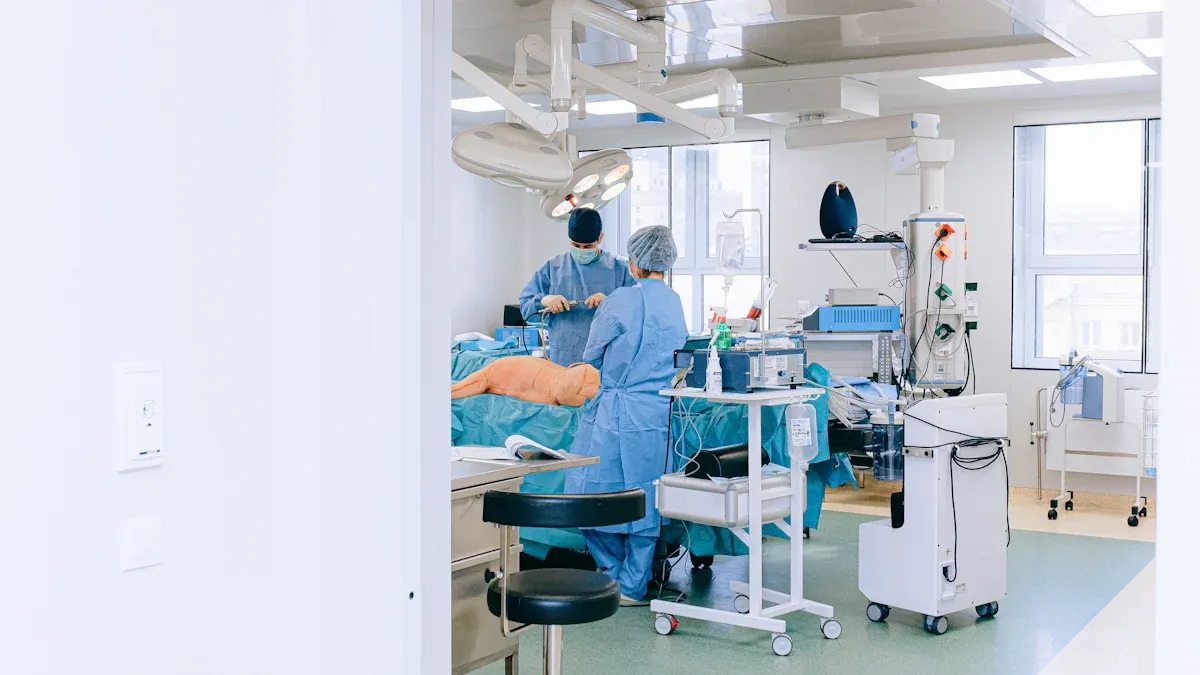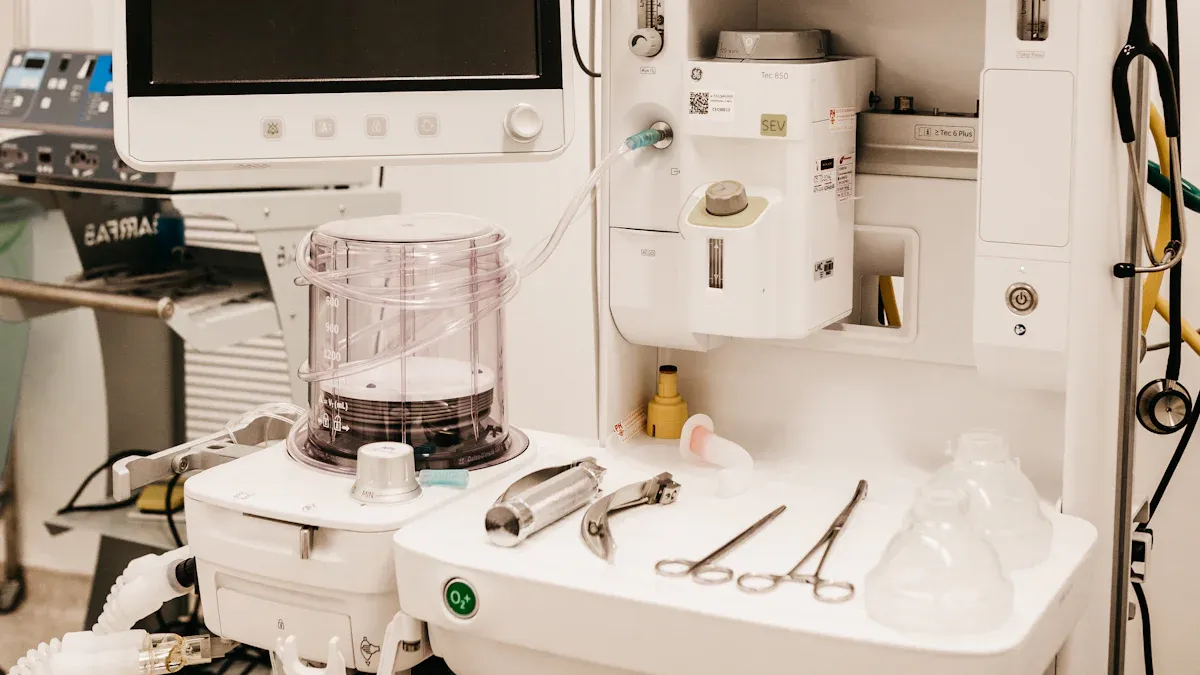Views: 0 Author: Site Editor Publish Time: 2025-07-07 Origin: Site










Anesthesia providers need to move fast if the anesthesia machine stops working during a procedure. Patient safety relies on quick action and clear decisions. The anesthesia machine can have problems like leaks, low pressure, or sudden alarms. These problems need a step-by-step way to check the machine. Every clinician must make sure anesthesia is given right and the equipment works well.
Patient safety is most important. Fixing the anesthesia machine fast can save lives.
Always put patient safety first. Act fast and stay calm if the anesthesia machine stops working.
Use manual ventilation right away. This helps the patient keep breathing while you check the machine.
Talk clearly with your team. Give out jobs and work together to fix problems quickly in emergencies.
Follow a step-by-step plan. Check the gas supply, breathing circuits, bellows, valves, and monitors one by one.
Do regular maintenance. Call repair experts if problems do not go away to keep the machine safe.
Patient safety is always the most important thing. The provider needs to stay calm and act fast. They should check the patient's vital signs right away. The team must make sure the patient is getting oxygen. If the machine stops working, the provider looks for signs of hypoxia or not enough anesthesia. They keep the patient stable while they look for the problem.
Tip: Always have a self-inflating bag or another ventilation device ready. This tool can help save lives if the machine fails.
If the anesthesia machine stops, the provider must use manual ventilation right away. They disconnect the patient from the machine and use a bag-valve-mask or similar device. This step makes sure the patient keeps getting oxygen and anesthesia gases. The provider watches for chest rise, breath sounds, and end-tidal CO₂. They change how they give breaths to keep oxygen and carbon dioxide levels normal.
Steps for Manual Ventilation:
Take the patient off the anesthesia machine.
Put a self-inflating bag or bag-valve-mask on the patient's airway.
Give breaths at the right speed and amount.
Watch how the patient responds and change as needed.
Manual ventilation keeps the patient safe while the team checks the machine.
Talking clearly and quickly helps the patient during anesthesia machine emergencies. The provider tells the surgical and nursing teams right away. They give jobs, like one person ventilating and another checking the machine. The team works together to find the problem and get backup equipment.
The table below shows how teamwork and talking help during anesthesia machine emergencies:
Teamwork Component | Communication-Driven Action | Impact on Patient Outcome |
|---|---|---|
Directive Leadership | Gives jobs and clear instructions | Finds problems faster |
Situational Awareness | Shares updates about patient and equipment | Spots problems early |
Team Orientation | Focuses on shared goals | Works together better |
Adaptability | Changes with new information | Responds quickly to changes |
Backup Behavior | Helps team members and gets ready for needs | Keeps patient safe |
Quick talking helps the team find the problem, use manual ventilation, and bring back anesthesia delivery. Each person helps keep the patient stable and fix the crisis.

A step-by-step plan helps clinicians fix problems fast. Troubleshooting anaesthesia machines starts with simple checks. Then, the team looks at each part of the system. This way, they find out what is wrong, like leakage or strange alarms. Each step keeps patients safe and helps the machine work well.
Gas supply problems can make the machine stop working. The provider should check the main oxygen source first. They look at the pressure gauges and cylinder levels. If there is no gas or an o2 failure alarm, the team must act fast. The oxygen warning may sound if the supply drops. Using a backup cylinder can bring back the flow.
Tip: Always check the oxygen supply before every case. Write down the machine number and make sure the gas source is safe.
Common gas supply issues:
Oxygen cylinders are empty or closed.
Pipelines are disconnected or bent.
Pressure regulators do not work right.
A quick check of these things often fixes the problem.
Breathing systems can leak or get blocked. The team should check the circuit for loose parts or cracks. Sometimes, a defect in the circuit makes a high-pitched sound. This can make it hard to give breaths, especially to kids. Checking the breathing circuit before use stops these problems.
Checklist for breathing circuit inspection:
Look for hoses that are loose or not connected.
Squeeze the bag and listen for leaks.
Check for bends or things stuck in the tubing.
Change any broken parts right away.
A table below shows common breathing system problems:
Problem | Possible Cause | Action |
|---|---|---|
Leakage | Loose parts or cracks | Tighten or change parts |
Obstruction | Bent tubing or something stuck | Remove or change the tube |
High-pitched sound | Circuit defect | Change the circuit |
Bellows and valves help with breathing. Leaks in the bellows can cause low breaths or let gas escape. A hole in the bellows can hurt the lungs or change oxygen levels. Valve problems, like a stuck disk, can change gas flow and CO₂ levels. Bad relief valves may be from loose lines or broken flapper valves.
Bellows leaks can lower anesthetic gas and cause awareness.
Valve problems can make airway pressure too high or too low.
Broken one-way valves may need cleaning or changing.
Troubleshooting anaesthesia machines means checking bellows and valves. If a part cannot be fixed, the provider should change it or use a new machine.
Monitors and alarms keep patients safe during anesthesia. The provider must make sure all monitors work before and during the case. Oxygen analyzers should have a low oxygen alarm. Pulse oximetry and capnography must have alarms the team can hear. Ventilators need alarms for disconnections.
Best practices for monitors and alarms:
Make sure all alarms are on and loud enough.
Check oxygen levels with an analyzer.
Use pulse oximetry and capnography from start to end.
Watch ECG, blood pressure, and temperature if needed.
Qualified anesthesia staff must stay to watch alarms and the patient. Regular checks and notes keep the system safe and working.
Troubleshooting anaesthesia machines means following each step in order. This finds leaks, blocks, or machine errors. It keeps patients safe and helps the anesthesia team.
Finding leaks and disconnections in breathing systems keeps patients safe. Providers listen for hissing sounds or feel for escaping gas. They check each connection by hand to find problems. Some use special leak detection liquids to spot small leaks. These liquids need careful cleaning after use. Ultrasonic leak detectors help staff hear leaks, but loud rooms make this hard. Advanced acoustic imaging devices can show leaks from far away. These tools work well with oxygen and nitrous oxide. They help staff find leaks fast and safely.
Quick leak detection tips:
Listen and feel for escaping gas.
Check all circuit connections.
Use leak detection liquids or acoustic devices if available.
Flow and pressure problems can cause trouble during anesthesia. Providers check the flowmeter to see if it works right. They make sure the bobbin or ball moves up and down. They look at the pressure gauge to see if numbers are normal. If flow drops or pressure falls, they look for leaks or blockages. Sometimes, a bent tube or blocked filter causes low flow. High pressure may mean a blocked valve or stuck bellows. Providers fix these by changing bad parts or clearing blockages.
Table: Common Flow and Pressure Issues
Problem | Possible Cause | Quick Check |
|---|---|---|
Low Flow | Kinked tube | Straighten tubing |
High Pressure | Blocked valve | Inspect and clear valve |
Flowmeter Fault | Stuck bobbin/ball | Tap or reset flowmeter |
Display or system failures can stop anesthesia delivery. Providers watch for blank screens or error messages. They check power cords and backup batteries. If monitors stop working, they check vital signs by hand. Oxygen sensors and alarms need to be tested often. Providers keep extra monitors and batteries ready to use. Acting fast helps keep patients safe during system problems.
Tip: Always test monitors and alarms before starting anesthesia. Keep backup equipment close.

Sometimes, quick fixes do not work. If the machine keeps having errors or makes odd sounds, stop using it. The team should call for anesthesia machine repair right away. If the machine loses power or shows error codes, it needs an expert. If gas does not flow or leaks keep happening, do not try to fix it alone. If alarms will not reset, get help. Reliable anesthesia machine repair services have trained people who know how to find hidden problems. They use special tools and follow safety rules. Calling for professional repair keeps patients safe and stops bigger problems.
Tip: Never ignore warning signs. If you are not sure, remove the machine and ask for anesthesia machine repair before the next case.
Common signs to call for repair:
Machine does not start or pass self-test.
Gas flow does not come back after checks.
Alarms keep going off for no clear reason.
Parts break or do not fit after you change them.
Regular care helps stop emergencies. The team should use a checklist before every case. They must look at all parts, like breathing circuits, vaporizers, and monitors. Preoperative checks help find leaks or broken seals early. Staff should write down each inspection and repair. Most experts say anesthesia machine repair and preventive maintenance should happen once or twice a year. The schedule depends on what the maker and hospital say. Following these rules keeps the machine safe and working well.
Key preventive maintenance practices:
Use a preoperative checklist for every case.
Check breathing circuits for leaks or blockages.
Test alarms and monitors before using them.
Plan anesthesia machine repair by manufacturer rules.
Teach staff about new equipment and safety changes.
Report and talk about any problems or close calls.
Maintenance Task | Frequency | Who Performs It |
|---|---|---|
Preoperative inspection | Before every procedure | Anesthesia provider |
Full preventive maintenance | 1-2 times per year | Certified technician |
Staff training and updates | Ongoing | Hospital educators |
Incident reporting and review | After every event | All team members |
Staying alert and following these steps helps stop breakdowns. Good records and regular anesthesia machine repair keep the system ready for every patient.
Using a step-by-step plan helps teams fix machine problems fast. Following the rules lowers the chance of things going wrong, as studies show. Checking and caring for the equipment often keeps it safe. If problems do not go away, teams should call experts to repair it. Talking clearly and fixing things on time keeps patients safe and helps good results.
The team should start using manual ventilation right away. They need to check the patient's vital signs quickly. They must tell the surgical team what happened. Keeping the patient safe is always the main goal.
Most experts say to do preventive maintenance once or twice a year. The exact timing depends on what the manufacturer says. Checking the machine often helps stop sudden problems.
Some signs are hissing sounds, low pressure numbers, and alarms. The team might also see lower oxygen levels. Acting fast keeps the patient safe.
The team should call for help if the machine fails self-tests or keeps having errors. Leaks that do not stop or strange noises mean you need an expert. Broken parts also need a professional to fix them.
A self-inflating bag, extra breathing circuits, and spare monitors should always be close by. These tools help the team keep the patient safe if the main machine stops working.